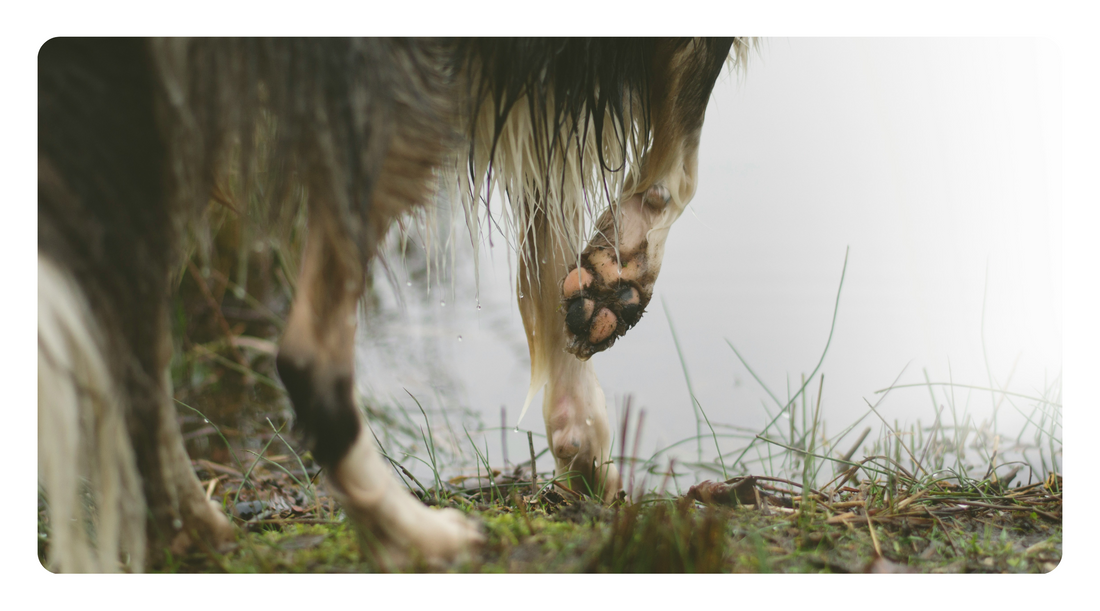Your dog’s paws are the first line of contact with the outside world, and they’re more than just furry footpads. These remarkable structures act as shock absorbers, temperature regulators, and sensory tools that help your dog navigate their environment. But because they come in constant contact with a variety of surfaces, paws are also vulnerable to toxic exposures, allergens, and abrasive damage.
If your dog licks or chews their paws often, avoids walking on certain surfaces, or shows signs of inflammation or discomfort, their paw health may be compromised. And while paw licking is often dismissed as a behavioral quirk, it’s frequently a sign that your dog is reacting to environmental triggers. Fortunately, with a proactive, natural approach, you can protect and heal your dog’s paws from the ground up.
Why Paw Protection Matters
Your dog’s paw pads are made up of layers of fat and connective tissue, covered by a thin but durable layer of skin. However, that outer skin is much more delicate than most pet owners realize. And because it comes into direct contact with environmental contaminants like lawn chemicals, sidewalk salts, pesticides, and allergens, it’s at high risk for irritation and absorption.
Once the paw barrier is compromised, it’s easier for bacteria, yeast, or environmental allergens to take hold, leading to chronic inflammation, discomfort, or even infections. And if your dog frequently licks their paws, that moisture can worsen irritation and delay healing.
Common signs of paw distress include:
-
Swelling, redness, or inflammation
-
Cracks, dryness, or bleeding
-
Hair loss between the toes
-
Yeasty or sour odor from the paws
-
Reluctance to walk on hard or hot surfaces
Proactive care not only improves your dog’s comfort, it also prevents chronic issues that often require repeated trips to the vet.
Common Paw Stressors to Watch Out For
1. Sidewalk De-Icers and Road Salt
In colder months, roads and sidewalks are often treated with chemical de-icers, which are highly irritating to paw pads. These substances can cause burns, dryness, and are toxic if ingested when your dog licks their feet.
2. Pesticides and Herbicides
Grass and sidewalks are often sprayed with weed killers and pesticides—many of which remain on surfaces for hours or days. These chemicals easily transfer to your dog’s paws and can disrupt hormone function and microbiome balance.
3. Hot Pavement and Asphalt
Even on days as mild as 75°F, pavement can heat up to over 120°F. Prolonged contact with hot surfaces can cause thermal burns and deep tissue damage, especially in summer.
4. Rough Terrain and Debris
Gravel, sand, sharp rocks, and rough trails can create microabrasions in your dog’s paw pads. These tiny cuts become entry points for bacteria and fungi, especially if your dog’s immune system is compromised.
5. Environmental Allergens
Grass, mold spores, pollen, and dust can stick to paws and accumulate between the toes. These irritants can trigger allergic reactions that show up as constant licking, chewing, or interdigital cysts.
How to Naturally Protect and Support Paw Health
1. Rinse or Wipe Paws After Every Walk
This is one of the simplest yet most effective things you can do. After every walk—especially on sidewalks, trails, or grassy areas—wipe your dog’s paws with a damp cloth or use natural paw wipes. You can also set up a shallow paw bath near the door with warm water and a splash of apple cider vinegar to remove allergens and neutralize pathogens.
Not only does this reduce the amount of toxins your dog absorbs or licks, but it also helps control allergens that can flare up sensitive skin or immune issues.
2. Apply a Natural Paw Balm Daily
Using a paw balm helps nourish dry, cracked pads while forming a gentle barrier against environmental stressors. Look for organic, chemical-free balms made with soothing botanicals and natural oils.
Beneficial ingredients include:
-
Shea butter: deeply moisturizing and anti-inflammatory
-
Coconut oil: antifungal and antibacterial
-
Beeswax: forms a breathable, protective barrier
-
Calendula: soothes inflammation and promotes tissue repair
-
Plantain: supports wound healing and soothes itching
Apply before walks for protection and after walks to soothe and moisturize.
3. Use Protective Booties for Harsh Conditions
If your dog tolerates them, booties can offer excellent protection in extreme weather or rough terrain. Use breathable, flexible booties in hot weather, and insulated versions during winter months.
Introduce booties gradually with short walks and positive reinforcement. Not all dogs love them at first, but many adjust over time.
4. Avoid Chemically Treated Areas When Possible
Be mindful of where you walk your dog. Parks, sidewalks, and lawns often receive chemical treatments that can linger on surfaces. Try to stick to natural paths, wooded trails, or your own chemical-free yard.
Ask your neighbors or local parks about their pesticide use. If your dog is especially sensitive, consider walking during off-hours when fewer treatments are likely to be present.
5. Strengthen Paw Health from the Inside Out
Topical protection is important, but true paw health starts from within. A nutrient-dense, anti-inflammatory diet supports healthy skin and strong barrier function.
Nutrients that support paw and skin health include:
-
Omega-3 fatty acids (from wild-caught fish like sardines or anchovies): reduce inflammation and improve skin elasticity
-
Zinc: supports immune function and wound healing
-
Biotin: improves keratin production for healthier skin and nails
-
Vitamin E: powerful antioxidant that protects cells from oxidative stress
-
Collagen or gelatin: support connective tissue and repair dry, cracked paws
Adding these through whole foods or supplements can make a dramatic difference in the condition of your dog’s paws, especially for dogs with allergies or autoimmune skin conditions.
Final Thoughts
Your dog’s paws work hard every day, and they’re more vulnerable than most of us realize. Whether it’s exposure to chemical de-icers, environmental allergens, or simply walking on abrasive surfaces, your dog’s paws take a daily beating. But with mindful prevention, daily maintenance, and nutrient support, you can help protect your dog from the inside out.
At The Organic Dog Shop, we’re passionate about helping your dog live their healthiest, most comfortable life. We offer a curated collection of USDA organic paw balms, skin-supportive supplements, dog-safe wipes, and toxin-free grooming essentials to keep your dog’s paws resilient and irritation-free.
Explore our paw care collection today and take the first step toward giving your dog the comfort, protection, and natural support they need—every single step of the way.

